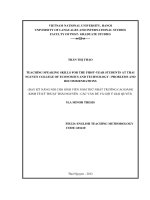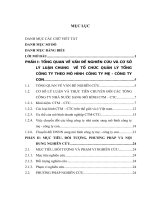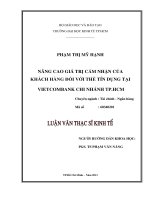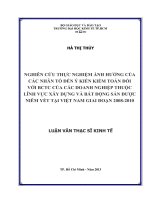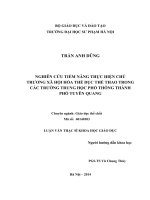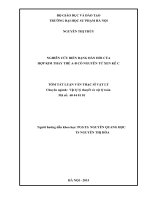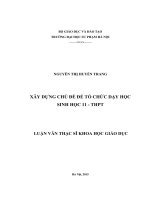(Luận văn thạc sĩ) adapting tasks for reading lessons in english for electricity to improve the english reading skill of the first year students at electricity faculty, sao do university
Bạn đang xem bản rút gọn của tài liệu. Xem và tải ngay bản đầy đủ của tài liệu tại đây (1.7 MB, 56 trang )
iii
ABSTRACT
Reading is one of the most important skills in learning English, especially ESP. For
first year students at Electricity Faculty in Sao Do University, reading has been given the
first priority and has been paid more attention as the students have to read English
materials related to their own specialist subject. This study has been conducted in an
attempt to investigate the difficulties in reading ESP materials, find out the necessity of
adapting and recommend techniques of adapting tasks for reading lessons in English for
Electricity to improve the reading skill of the first year students at Electricity Faculty, Sao
Do University.
The subjects involved in the study are 8 English teachers who have taught English
for Electricity and 100 students of Electricity Faculty chosen at random from 3 classes.
They were in their first year and have just finished studying English for Electricity. The
data collected from questionnaires and notes from class observation reveal that it is
necessary to adapt reading tasks to facilitate reading process and help students to obtain
desirable achievements in ESP reading.
The analysis of the data collected has helped the researcher to come at several
problems in both teaching and learning ESP in general and reading skill in particular.
Stemming from the findings, the author has put forward adapting tasks in reading lessons
of English for Electricity to improve reading skill of the first-year students at Electricity
Faculty, Sao Do University.
iv
LIST OF TABLES, FIGURES AND ABBREVIATION
1. Tables:
Table 1 – Exercises believed to be suitable to develop reading skills
Table 2: English for Electricity’s Units
Table 3: Students’ evaluation of the difficulties of different units in the textbook
Table 4: Teachers’ evaluation of the difficulties of different units in the textbook
Table 5: Teachers’ and students’ preferences for the reading activities
2. Figures:
Figure 1: Students’ places of domicile
Figure 2: Students’ time of learning English
Figure 3: Students’ purposes in learning ESP
Figure 4: Students’ evaluation of the difficulties in learning English for Electricity
Figure 5: Teachers’ evaluation of the difficulties in learning English for Electricity
Figure 6: Students’ views of the difficulties of reading strategies
Figure 7: Teachers’ evaluation of the necessity of reading strategies
Figure 8: Students’ views on the reference materials
Figure 9: Time of students’ studying outside the classroom
3. Abbreviations:
GE: General English
ESP: English for Specific Purposes
CLT: Communicative Language Teaching
EFL: English as a Foreign Language
DC: Direct current
v
TABLE OF CONTENTS
Acknowledgements...............................................................................................................ii
Abstract.................................................................................................................................iii
List of tables, figures and abbreviations........................................................ ......................iv
Table of contents...................................................................................................................v
PART I: INTRODUCTION...................................................................................................1
I.1. Rationale..............................................................................................................1
I.2. The aim of the study.............................................................................................1
I.3. Research questions...............................................................................................2
I.4. Scope of the study................................................................................................2
I.5. Organization of the study.....................................................................................2
PART II: DEVELOPMENT..................................................................................................3
CHAPTER I: LITERATURE REVIEW................................................................................3
I.1. ADAPTATION................................................................................................................3
I.1.1. Definition..........................................................................................................3
I.1.2. Adapting techniques..........................................................................................3
I.1.2.1. Adding............................................................................................................3
I.1.2.2. Deleting or Omitting......................................................................................3
I.1.2.3. Modifying.......................................................................................................4
I.1.2.4. Simplifying.....................................................................................................4
I.1.2.5. Re-ordering....................................................................................................5
I.2. READING........................................................................................................................5
I.2.1.What is reading and reading comprehension?...................................................5
I.2.1.1. The definition of reading................................................................................5
I.2.1.2. Reading comprehension.................................................................................6
I.2.2. Reading techniques...........................................................................................6
I.2.3. Reading skills in English for Specific Purposes...............................................7
I.3. TASK IN LANGUAGE TEACHING AND TASK DESIGNING.................................9
I.3.1. Task in language teaching.............................................................................................9
I.3.2. Task designing............................................................................................................10
CHAPTER II: THE STUDY...............................................................................................13
vi
II.1. SETTINGS...................................................................................................................13
II.1.1. The syllabus...................................................................................................13
II.1.2.The teachers....................................................................................................14
II.1.3. The students...................................................................................................15
II.2. THE SUBJECTS..........................................................................................................15
II.3. THE RESEARCH INSTRUMENTS AND PROCEDURE.........................................16
CHAPTER III: DATA ANALYSIS, DISCUSSION AND RECOMMENDATIONS........17
III.1. QUESTIONAIRE DATA ANANYSIS AND DISCUSSION....................................17
III.1.1. Students’ background of learning English and their purposes in learning ESP.......17
III.1.2. Evaluation of the difficulties in learning English for Electricity.............................19
III.1.3. Evaluation of the difficulties of different units in the textbook. .............................22
III.1.4. Evaluation of reading skills......................................................................................23
III.1.4.1. Students’ views of the difficulties of reading strategies............................23
III.1.4.2. Teachers’ evaluation of the necessity of reading strategies......................24
III.1.5. Teachers’ and students’ preferences for the reading activities.................................25
III.1.6. Reference materials for students..............................................................................26
III.1.7. Time of students’ studying outside the classroom...................................................27
III.1.8. Summary..................................................................................................................27
III.2. RECOMMENDATIONS............................................................................................29
III.2.1. Some adjustments of teaching and learning.............................................................29
III.2.1.1. Promoting students with a variety of reading strategies............................29
III.2.1.2 Encouraging students to develop learning habit outside class...................29
III.2.2. Adaptation of the reading tasks in English for Electricity.......................................30
III.2.2.1. Simplifying................................................................................................30
III.2.2.2. Modifying..................................................................................................34
III.2.2.3. Adding.......................................................................................................37
III.2.2.4. Deleting or Omitting.................................................................................41
PART III: CONCLUSION...................................................................................................44
REFERENCES.....................................................................................................................45
APPENDIXES........................................................................................................................I
APPENDIX 1..........................................................................................................................I
APPENDIX 2.......................................................................................................................IV
1
PART I: INTRODUCTION
I.1. Rationale
English has experienced its popularity in Vietnam over the last few decades. Together
with the development of General English (GE), English for Specific Purposes (ESP) has
become an indispensable branch in English Language Teaching in Vietnam to meet the
growing demand for communicating with foreigners and updating information as well as
technology in the fields of electrical engineering, electronics, computer science and
engineering…
ESP is a compulsory subject in the training curriculum at Sao Do University. Students
at Electricity Faculty are supposed to study a certain command of ESP relating industrial fields
such as: electrical engineering, electric power system, electric power in industry and
household. However, ESP teaching has encountered a number of problems such as long and
difficult reading texts, students’ electrical knowledge limitation, and lack of experienced
teachers of ESP. Another problem of great concern of the ESP teachers is syllabus, especially
its tasks and activities for practicing reading skill. The ESP syllabus for the first-year students
of Electricity Faculty – English for Electricity is not an exception. And the desire of how to
improve the effectiveness of reading lessons is really the strong motivation.
All the above mentioned reasons lead to the choice of the study: “Adapting tasks for
reading lessons in English for Electricity to improve the English reading skill of the firstyear students at Electricity Faculty, Sao Do University”
I.2. The aim of the study
The study aims to:
- develop a theoretical framework which is appropriate for adapting tasks for reading lessons
in English for Electricity for the first year students at electricity Faculty, Sao Do University.
- investigate and analyze the difficulties the first year students of Electricity Faculty may
encounter when studying the reading lessons in English for Electricity.
- adapt some reading tasks in English for Electricity for the first year students at electricity
Faculty, Sao Do University.
2
I.3. Research questions
1. What difficulties may the first-year students of Electricity Faculty encounter when
studying the reading lessons in English for Electricity?
2. What reading tasks are considered inappropriate for the first-year students of
Electricity Faculty?
3. What reading tasks in English for Electricity should be adapted?
I.4. Scope of the study
This study is limited to the area of investigating and analyzing the difficulties the first
year students of Electricity Faculty may encounter when studying the reading lessons in
English for Electricity. More importantly, the focus of the study is to suggest techniques to
adapt some reading tasks in this textbook to improve the students’ reading skill.
I.4.
I.5. Organization of the study
The study is expected to consist of three main parts.
Part I includes rationales, aims of the study, research questions and scope of the study.
Part II includes 5 chapters
Chapter 1 deals with the theoretical background relevant to the research topic including
adaptation, an overview of reading, tasks in language teaching and task designing.
Chapter 2 provides with current situation of teaching and learning reading skill in the
Electricity Faculty, Sao Do University and introduces the research methodology.
Chapter 3 presents the findings of the study resulting from a statistical analysis of the collected
data and some extra reading tasks for “English for Electricity”
Part III presents conclusion of the study
References
Appendix
3
PART II: DEVELOPMENT
CHAPTER I: LITERATURE REVIEW
I.1. ADAPTATION
I.1.1. Definition
According to Madsen and Bowen (1978: ix), adaptation is an action of employing “one
or more of a number of techniques: supplementing, expanding, personalizing, simplifying,
modernizing, localizing, or modifying cultural/ situational content”. Similarly, from
Tomlinson (1998:xi) took the same position that adaptation referred to “reducing, adding,
omitting, modifying and supplementing”. Adaptation is a term referring to the ability to adjust
to new information and experiences. Learning is essentially adapting to our constantly
changing environment. Through adaptation, we are able to adopt new behaviors that allow us
to cope with change.
I.1.2. Adapting techniques
I.1.2.1. Adding
The notion of addition is that tasks of a textbook are supplemented by putting more
into, while taking into account the practical effect on time allocation. First, we can certainly
add in this quantitative way by the technique of extending "This means that the techniques are
being applied within the methodological framework of the original materials: in other words,
the model is not itself changed" (McDonough and Shaw, 1993:89). We can do this in the
following situation: A second reading passage parallel to the one provided is helpful in
reinforcing the key linguistic features - tenses, sentence structures, vocabulary, cohesive
devices - of the first text. Second, more far-reaching perspective on addition of materials can
be termed expanding. This kind of addition is not just extension of an existing aspect of
content. They go further than this by bringing about a qualitative as well as a quantitative
change... This can be thought of as a change in the overall system' (McDonough and Shaw,
1993:90).
I.1.2.2. Deleting or Omitting
Deletion is clearly the opposite process to that of addition. As we saw in the previous
section that tasks can be added both quantitatively (extending) and qualitatively (expanding),
4
the same point applies when a decision is taken to omit tasks. The most straightforward aspect
of reducing the length of tasks is subtracting. Addition and deletion often work together. A
task may be taken out and then replaced with something else. The methodological change is
greater when, for example, grammar practice is substituted after the omission of an
inappropriate communicative function.
I.1.2.3. Modifying
Modifying can be sub-divided under two related headings. The first of these is
rewriting, when some of the linguistic content needs modification, the second is restructuring,
which applies to classroom management.
- Rewriting may relate activities more closely to learners' own background and interest,
introduce model of authentic language, or set most purposeful problem-solving tasks
where the answers are not always known before the teacher asks the question.
- Restructuring: For many teachers who are required to follow a course book rather
strictly, changes in the structuring of the class are sometimes the only kind of adaptation
that is realistically possible. For example, the materials may contain role-play activities
for groups of certain size. The logistic of managing a large class (especially if they all
have same LI) are complex from many points of view, and it will probably be necessary
to assign one role to a number of pupils at the same time. Obviously the converse where the class is too small for the total number of roles available - is also possible if perhaps
less likely.
I.1.2.4. Simplifying
The technique of simplification is a type of modification, namely a "rewriting" activity.
The elements of a language which can be simplified are: the instructions and explanations that
accompany exercises and activities, and even the visual layout of materials so that it becomes
easier to see how different part fit together. However, texts, most often reading passages are
applied this technique. Usually, the emphasis has been on changing various sentences - bound
elements to match the text more closely to the proficiency level of a particular group of
learners. Simplification could be in the following forms: Sentence structure; Lexical content,
and grammatical structures.
5
Simplification has a number of further implications. Firstly, once linguistic items are
changed, stylistics will be affected, and therefore the meaning of intention of the original text
is changed. Secondly, simplification of content is required when the complexity of the subjectmatter is regarded as being too advanced. Thirdly, simplification can refer to the ways in
which the content is presented: we may decide not to make any changes to the original text,
but instead to lead the learners through it in a number of graded stages.
I.1.2.5. Re - ordering
This procedure refers to the possibility of putting the parts of a course book in a
different order. This may mean adjusting the sequence of presentation within a unit, or taking
units in a different sequence from that originally intended.
I.2. READING
I.2.1. What is reading and reading comprehension?
I.2.1.1. The definition of reading
On the teaching point of views, language skills consist of four-macro skills: listening,
speaking, reading and writing. Of the four skills, Carrel(1988) says that “for many students,
reading by far is the most important of four skills in a second language, particularly in English
as a second or foreign language”. So “what is reading?” To answer the question, numerous
attempts have been made, but according to Smith (1985) there is no point in looking for a
simple definition of reading. Nuttal (1996:3) stated that reading is “a process whereby one
looks at and understands what has been written”. Also, Goodman(1971:135) defined “reading
is psycholinguistics process by which the reader, language user, reconstructs, as best as he can,
a message which has been encoded by writer as a graphic display” For Goodman, this act of
reconstruction is viewed a cyclical process of sampling, predicting, testing and confirming.
And according to Smith (1985:102), “reading is understanding the author’s thought”. It means
that the readers “read the author’s mind not the author’s words”.
From these definitions, each author reflects what reading means as seen from his own
points of view. All what they share is that they try to find out the nature of reading and reading
act, in which the readers, reading process, and reading message are emphasized.
6
I.2.1.2. Reading comprehension
Reading comprehension plays an important part in teaching and learning a foreign
language. According to Swam (1975:1), “a student is good at comprehension” if “he can read
accurately and efficiently, so as to get the maximum information of a text with the minimum
understanding”. Grellet (1981: 3) defined reading comprehension: “understanding a written
text means extracting the required information from it as effectively as possible”. In
highlighting the importance of reading comprehension Rivers (1981:147) stated that “ reading
is the most important activity in any language class, not only as a source of information and a
pleasurable activity, but also as a means of consolidating and extending one’s which are
knowledge of the language”. Eskey (1988) considered in advanced levels of second language
the ability to read the written language at a reasonable rate and with good comprehension has
long been recognized to be as oral skills if not more important.
Though the authors mentioned above may not have exact same ideas, they all come up
the common point that reading comprehension is the process in which the readers, as they
read, can recognize the graphic forms of the reading text and understand what is implied
behind these forms.
I.2.2. Reading techniques
In reading, the objective of the reader is not always to understand which is written
down. According to Grellet(1981:4), there are 4 main ways of reading: skimming, scanning,
extensive reading and intensive reading.
Skimming
Grellet(1981:4) defined skimming as “quickly running one’s eyes over a text to get the
gist of it”. Skimming is used to get main points or the intention of the writer, quickly gather
the most important information, or 'gist', run one’s eyes over the text and note important
information. Skimming is to quickly get up to speed on a current business situation. It's not
essential to understand each word when skimming.
Scanning
Scanning is used to find a particular piece of information. The reader goes through the
text very quickly in order to look for the specific piece of information. While scanning, we
7
ignore all the other information until we find the specific details. In contrast with skimming,
scanning is far more limited since it only means retrieving needed information.
Extensive reading
Extensive reading is a relatively rapid and efficient process where readers are supposed
to read large quantities of material or long texts for global understanding, the principle goal
being obtaining pleasure from the text. Grellet(1981:4) assumes “extensive reading: reading
longer texts, usually for one’s own pleasure. This is a fluency activity, mainly involving global
understanding”. In language teaching, the reading is individualized, what means that students
choose books they want to read, they read it independently of the teacher and they not required
to do any tasks after reading.
Intensive reading
Unlike extensive reading, intensive reading deals with shorter texts to extract specific
information. The reader is is required to have deep understanding of the text. Intensive reading
aims at understand not only of what the text means, but of how the meaning is produced.
Brown (1989) explains that intensive reading "calls attention to grammatical forms,
discourse markers, and other surface structure details for the purpose of understanding literal
meaning, implications, rhetorical relationships, and the like."
In conclusion, it’s important for students to develop reading strategies and techniques
which will aid in learning, understanding, and retaining key concepts from textbooks,
essays, novels, technical materials, and other kinds of reading. These reading techniques will
undoubtedly guide students in becoming a stronger, more critical reader. Reading is not an
isolated activity; it should be integrated with the improvement of all
I.2.3. Reading skills in English for Specific Purposes
Dudley-Evans and Jo St John (1998:96) assumed that one of the most important
contributions to the approach to reading in ESP was the shift from ‘text as a linguistic object’
(TALO) to ‘text as a vehicle of information’ (TAVI). It is clear that the most important factor
marking the different between reading in ELT and ESP is the change in the approaches in
reading. By the latter they mean that in ESP the readers pay more attention to extracting
information quickly and accurately rather than the language details. That is ‘understand the
8
macrostructure comes before language study’ and ‘application of the information in the text is
of paramount importance.’ (Dudley – Evans and Jo St John, 1998:96).
In regard to the balance between language and skills in ESP, they proposed that good
reading requires language and skills. Thus, in order to be a good reader in foreign language the
student needs to reach a threshold of language before they are able to transfer any skills from
their first language to those in the foreign language. All in all, any reading ESP course requires
language to be developed along with the skills. Dudley – Evans and Jo St John (1998) list the
key skills to be learned and transferred into the new language as follows:
Selecting what is relevant for the current purposes;
Using all the features of the text such as headings, layout, type face;
Skimming for content and meaning;
Scanning for specifics;
Identifying organizational patterns;
Understanding relations within a sentence and between sentences;
Using cohesive and discourse markers;
Predicting inferring and guessing;
Identifying main ideas, supporting ideas and examples;
Processing and evaluating the information during reading;
Transferring or using the information while or after reading.
(Dudley – Evans and St John 1998:96)
Although ESP reading is usually related to particular content areas such as technology
or engineering, the recent trends in ESP seem to share the assumption that readers’ strategies
can be generalized across subject boundaries. This means general reading strategies should be
taught to ESP students because, as Hutchinson & Waters (1987) point out, ESP is not different
in kind from any other form of language teaching and ESP teaching should be based on the
principles of effective and efficient learning.
9
I.3. TASK IN LANGUAGE TEACHING AND TASK DESIGNING
I.3.1. Task in language teaching
The varying definitions of tasks have been well covered in the literature in general and
a lot of tasks are adapted or designed based on the theory and characteristics of CLT. Ellis
(2003: 3) has summarized and added his own concise definition as follows: "Tasks are
activities that call for primarily meaning-focused language use". Another well-known
definition is provided by Nunan (1989:10). He considers a task as “any classroom work which
involves learners in comprehending, manipulating, producing, or interacting in the target
language while their attention is principally focused on meaning rather than form”. More
recently, Skehan (1998:147) summarizes the parameters for a task activity in the following
way:
“(a) meaning is primary,
(b) learners are not given other people’s meanings to regurgitate,
(c) there is some sort of relationship to comparable real-world activities,
(d) task completion has a priority,
(e), the assessment of tasks are done in terms of outcome”
From these definitions, despite the various interpretations, several common design
features can be identified. These features include: All three definitions emphasize the
importance of focus on meaning. This criterion supports the notion that conveying an intended
meaning is the essence of language use. Skehan’s (1998) definitions emphasize the use of realworld tasks or activities that are comparable to authentic task behavior. Performing real-world
tasks also necessitates the use of real language to accomplish these tasks. Meanwhile, Nunan’s
(1989) definition makes specific reference to the classroom environment and points out that
task performance may entail employing a single skill or a combination of several skills. His
description recognizes the pedagogical needs for focusing on skills in isolation in language
learning.
A task in language teaching can be seen as the deployment of grammatical knowledge
to express meaning, highlighting the fact that meaning and form are highly interrelated, and
that grammar exists to enable the language user to express different communicative meanings.
10
However, as Willis and Willis (2001) point out, tasks differ from grammatical exercises in that
learners are free to use a range of language structures to achieve task outcomes - the forms are
not specified in advance. Concerning the distinction between "tasks" and "exercises", Ellis
(2003: 3) classifies tasks as "activities that call for primarily meaning focused language use"
and "exercises" as activities "that call for primarily form focused language use". Furthermore,
Ellis (2003:3) emphasizes that "the overall purpose of tasks is the same as exercises, learning a
language- the difference lying in the means by which this purpose is to be achieved”.
I.3.2. Task designing
Learning tasks, according to Prabhu(1987), can be classified into three principle
activity types:
1. Information-gap activities, which operate on the principle of supplying information to some
students and withholding it from others. Prabhu provides the example of pair work in which
each member of the pair has a part of the total information and attempt to transfer it verbally to
the other.
2. Reasoning-gap activities, which involve deriving some new information from given
information through possessed of inference, deduction, practical reasoning, or a perception of
relationships or patterns.
3. Opinion-gap activities, which engage in learners in identifying and articulating a personal
preference, feeling or attitude in response to a given situation such as story completion or
taking part in the discussion of some issues. In performing this activity, students may use
factual information and formulating arguments to justify their opinions.
According to Hutchinson and Waters (1987), in order to maximize the chances of
learning, it is important to design a clear, systematic but flexible material with different types
of tasks. Grellet (1981:12-13) listed a number of exercise – types focusing on the formal
organization and the contents of the text to develop reading skills. They are classified into four
main types: reading techniques, the form analysis of the text, the understanding of the meaning
in the text, and the assessment of the text. Among various tasks proposed by Grellet(1981),
those listed in table 1 are believed to be used more often in ESP reading. Kenedy and Bolitho
11
(1991: 74-84) suggested several types of exercises, which can be used to train self-studying
strategies towards reading ESP materials:
1. Reference skills
2. Skimming
3. Scanning
4. Relating graphs, diagram to texts
5. Predicting and sequencing the structure of the text
6. Understanding elliptical writing-telexes
7. Reading instructions and notices (survival reading)
Reading techniques
Form analysis of the text
1. Inference using contextual 1.Chronological sequence
12
Understanding of the meaning in the
text
Assessment of the text
1. Ordering sequences of pictures
1. Deciding fact or opinion
2. Comparing texts and pictures
2.
clues, or word formation
2. Linking sentences and ideas 2. Analogy and contrast
using Reference, link words
3. Predicting
intention
3. Classification
4. Anticipation
Finding
3. Matching
4. Completing a document
(a table,
charts,)
5. Skimming
5. Reordering events using tables
6. Scanning
6. Comparing several texts: note – taking
7. Inference using
7. Question – types:
Multiple choices
True/False
Completing a summary
Completing sentences
Table 1 – Exercises believed to be suitable to develop reading skills (Grellet, 1981; 4-5)
writer’
s
13
CHAPTER II: THE STUDY
II.1. SETTINGS
II.1.1. The syllabus
The study is conducted at Electricity Faculty, Sao Do University. The main duty of Sao
Do University is to train technicians and engineers for industrial fields such as: electrical
engineering, electric power system, electric power in industry and household. The overall
curriculum of the University lasts for 4 years in which English is taught in the first year with
120 periods (45 minutes each) into two stages: GE and ESP.
The General English is taught in 75 periods for which we use the course book Lifeline
– Elementary by Tom Hutchinson, Oxford University Press. It is considered to be the most
important stage to develop students’ language skills. The main objectives for this stage are to
provide students with basic communicative skills: listening, reading, writing and speaking.
However, at the end of the first term, students have a written exam which includes mainly
grammar and vocabulary exercises.
The second stage is 45 periods for ESP. The material for this stage is English for
Electricity designed by a group of teachers working in the Faculty of Tourism and Foreign
language as follows:
Order
Units
Periods
1.
Unit 1: What is this object called?
3
2.
Unit 2: Circuit elements.
6
3.
Unit3: Conductors, insulators and semiconductors.
6
4.
Unit 4: Shapes and measurement.
3
5.
Unit 5: Safety rules
3
6.
Unit 6:The effects of an electric current
3
7.
Unit 7: Electronics in the home.
3
8.
Unit 8: The DC motor
6
9.
Unit 9: Nuclear Energy.
3
10.
Unit 10: Getting a job.
6
11.
Revision
3
Table 2: English for Electricity’s Units
14
This book consists of reading texts followed by various tasks related to the texts. The texts
were taken from different sources mainly based on some textbooks about Electricity as
follows:
- English for technical students ( Nguyễn Thị Tuyết, 2000, Vietnam Education Publishing
House)
- English in Electrical Engineering and Electronics (E. rich H Glendinning, 1990, Oxford
University Press)
- Oxford English for Electronics (E. rich H Glendinning, 1996, Oxford University Press).
Most of them are authentic texts covering a wide range of topics related to Electricity
such as: electric current, electric circuit, materials, electric motor, the effects of electric current
… English for Electricity aims at providing students with a great deal of technical terms and
developing students’ reading strategies and techniques, however, English for Electricity has
shown for some problems. It only lists lots of technical words but lacks exercises to help
students remember them. My colleagues complain that it is difficult for them to understand
some texts because they consist of a lot of technical terms and meanings. In addition, it also
lacks varied tasks and activities following the reading texts.
II.1.2.The teachers
The Faculty of Tourism and Foreign Languages has 42 teachers, among them 19
teachers are English teachers ageing from 23 to 38 and the other English teacher is 56. Only
five of them are holding MA degree in English Methodology and five of them are working
toward M.A degree in English. The rest holds a B.A in English language teaching. The oldest
teacher has more than 20 years teaching experience and the youngest one has taught for a year.
Each of our teachers is usually assigned at least 20 periods per week to teach both GE and
ESP. During the lessons, teachers play a key role and they are the main speakers working with
the texts. The teachers usually explain new words, new expressions, new structures and then
translate the texts in to Vietnamese. English teachers at Sao Do University are willing to take
up ESP course, although none of them have been trained to be the teachers of ESP or taken
any course on electricity. They have to face many difficulties: eg to understand professional
knowledge, and how to choose a suitable teaching methodology. As the result, they do not feel
15
confident in teaching English for Electricity. This may leads to unsatisfactory performance in
the classroom.
II.1.3. The students
The first – year students at the Electricity Faculty aged from 18 to 20, mainly male
students. Each class consists of about 40 to 60 students. They have 45 periods of English for
Electricity and only 3 periods per week. English for Electricity is the compulsory subject that
students have to study in the first year. They start to learn English for Electricity but they
haven’t learnt their major subject – Electricity. So they have had little electrical knowledge.
Therefore most of them find it difficult to discuss topics related to electricity. Another factor is
that most students have studied English at school and they are also supposed to acquire
English at elementary level at our University, but their English levels are quite different. In the
same class, some students find classroom activities relaxing while others find them too hard to
study. In addition, the students are quite passive in learning. The typical learning style of the
students is dependent on the teachers in reading lessons. They usually ask their teachers to
explain new words, structures and translate the text into Vietnamese instead of discussing with
their partners or looking up the dictionary.
II.2. THE SUBJECTS
The study was carried out with the participation of 100 students of Electricity Faculty
and 8 English teachers of the Faculty of Tourism and foreign languages.
The students were selected at random from 3 classes 06TDH1, 06TDH2, and 06HTD1.
They were in their first year and have just finished studying English for Electricity. Of these
students 87 are male and 13 are female. They come from different provinces throughout the
country. All of them are from 18 to 20 years of age.
The 8 teachers of English at the University are chosen for the investigation because
they have taught English for Electricity, 7 of them are female and one is male. 3 of them are
MA in English teaching methodology, one is doing the MA course in English teaching
methodology, 4 are holding the BA degree.
16
II.3. THE RESEARCH INSTRUMENTS AND PROCEDURE
The research method applied is the survey. The data collection instrument is
questionnaire. Survey questionnaire was chosen because it allowed collecting a large amount
data in a relatively short time. It was also a cheap way of collecting data.
The questionnaires are sets of closed and open questions in order to enable English
teachers and students of Electricity Faculty to state their own views. These questionnaires
were written in Vietnamese so that they would not misunderstand the questions. The content
of these two types of questionnaires is similar in five questions.
The first questionnaire was designed for 100 Electricity Faculty’s students. It aimed at
collecting information about their background which included their place of domicile, the
number of years they have been learning English and their purposes of learning ESP. It was
also conducted to investigate the difficulties in reading lessons, in reading skills, their studying
outside class and to identify the reading activities which interest students.
The questionnaire was given to students’ right after they had finished studying English
for Electricity in hope of obtaining their fresh comment and opinions. The author came to
different dormitory rooms to distribute the questionnaires for students to complete
individually. They were asked the questions in about 30 minutes. After they finished, the
author collected the questionnaires and got the data for analysis.
The questionnaire designed for English teachers consists of 6 questions. Most of the
teachers showed their concern about the study and willing to complete the survey with helpful
comments and advice. The questionnaire was completed in about 15 minutes for investigating
the teachers’ experience in teaching English for Electricity, their evaluation of reading lessons
in English for Electricity. In addition, it also aimed to find out their attitudes towards the
difficulties the first year students of Electricity Faculty may encounter when studying the
reading lessons in English for Electricity and their choice of reading activities that improved
students’ reading skills
17
CHAPTER III: DATA ANALYSIS, DISCUSSION AND RECOMMENDATIONS
III.1. QUESTIONAIRE DATA ANANYSIS AND DISCUSSION
III.1.1. Students’ background of learning English and their purposes in learning ESP
In the questionnaire for students, three questions were designed to explore their
background including their places of domicile, the number of years they have been learning
English and their purposes of learning ESP.
13%
country sides
cities or towns
87%
Figure 1: Students’ places of domicile
The first question is to find out the students’ place of living before entering University.
This is considered to be related to their conditions for learning English. Students from cities or
towns seem to have more favorable and better conditions for learning English while students
from the countryside do not have such conditions or do not pay much attention to this subject.
In answering this question, a great number of respondents (87%) come from the country sides
where the English learning condition is poor; they only learn from the textbooks in class and
hardly have reference books. The rest (13%) are from the cities or towns.
19%
11%
8 years
11 years
a year
4 years
6%
64%
Figure 2: Students’ time of learning English
18
Question 2 is designed to identify students’ time of learning English. It can be seen
from the figure 2 that most of them (64%) had learnt English for 8 years, another 19% had
learnt for 4 years. Interestingly, there are six students who had learnt English for 11 years.
However, the number of students who started learning English when they entered the
University is quite big (11%) because they learnt French or Russian at secondary and high
schools.
From the results of the two questions, a conclusion can be drawn out that the first year
students’ English levels at the Faculty of Electricity are varied because they come from
different places, have different English learning conditions, and moreover, they have different
time of learning English. This leads to a variety of purposes when the students take the ESP
course, as shown in the figure 3 below.
57%
52%
60%
42%
50%
40%
30%
12%
20%
10%
0%
5%
To continue studying in a
speaking English country
To understand technical
documents
To strengthen English
basic grammar
To apply for a job in the
future
To pass the ESP course’s
examinations
Figure 3: Students’ purposes in learning ESP
The figure summarizes the students’ purposes of learning ESP course. As can be seen
from the figure, to understand technical documents and to apply for jobs in the future are the
goals of many students. 57% of the students thought that when taking ESP course they might
get technical words and expressions to understand technical documents. This could result from
the fact that the participants need to be able to read English materials related to their specific
subject area. The number of students who expect to get a good job in the future is quite high,
accounting for 52%. They are aware of the importance of English to future career.
19
The number of students who think they study ESP course in order to pass the exams ranked
the third, accounting for 42%. The author thinks the data reflects a reality at Sao Do
University. The students study ESP in the first year, therefore by the time they graduate they
may have forgotten most of it and the command of ESP will not be enough for them and their
careers in the future. Only 12% of the students want to strengthen basic English grammar
during the ESP course. This can be interpreted that learning ESP is supposed to be beneficial
from the basic knowledge of General English learning however for some students, grammar
still plays an important role. They want both technical terms and grammar to improve their
English. The number of the informants pursuing further education in a speaking English
country makes up for 5% of the total number. Studying aboard seems not to be favored
because most of the students come from the countryside.
To know students’ background and purposes of learning ESP is necessary for the study.
III.1.2. Evaluation of the difficulties in learning English for Electricity
The issues deal with the students and teachers’ evaluation of the difficulties the first
year students of Electricity Faculty may encounter when studying the reading lessons in
English for Electricity. The results from respondents are presented as follows:
100%
78%
The texts are too long and full
of new words
86%
78%
The students lack electrical
knowledge
80%
60%
40%
20%
0%
20%
The students’ General English
level is limited
The teachers doesn’t give the
students sufficient practice of
grammar and vocabulary
Figure 4: Students’ evaluation of the difficulties in learning English for Electricity
20
The texts are too long and full
of new words
75%
80%
62.5%
The students lack electrical
knowledge
70%
60%
50%
40%
30%
25%
12.5%
The students’ General English
level is limited
20%
10%
0%
The teachers doesn’t give the
students sufficient practice of
grammar and vocabulary
Figure 5: Teachers’ evaluation of the difficulties in learning English for Electricity
As data shown in the figure 4 and the figure 5, the difference in percentage for each
choice between the teachers’ and the students’ responses is not great. Most of the students and
teachers found the main courses of their difficulties. 78% of the students thought that the texts
in English for Electricity are long and number of new words is great. Similar to students’
views, many teachers (75%) supposed for the first items. The students also determined their
lack of professional knowledge (86% of respondents). This comment also came from 62,5% of
teachers. It is noticeable that most of the lessons in English for Electricity are reading texts
relating to Electricity. Before attending the ESP course, they haven’t learnt their major subject
– Electricity. So they have had little electrical knowledge. It is difficult for them to understand
the texts by guessing new words’ meanings or even looking up the dictionary. On the contrary,
a quarter of those teachers and 20% of the students supposed that students’ problem in
learning English for Electricity was General English limitation. In fact, the texts in English for
Electricity mainly focus on technical terms and not many complex grammatical structures.
Topics about electric current, electric circuit, electric motor are mainly present simple present
tense.
From the figure 4, 78% of the students complained for not being given frequent and
sufficient practice of vocabulary and grammar, however, from the figure 5, only a teacher
(accounting for 12,5%) supported for this item. The students seemed to expect their teachers to
21
demonstrate the vocabulary and grammar with examples especially and spend more time for
them to practice. The above evaluation of the difficulties should be considered in the process
when adapting tasks in English for Electricity for the first year students of Electricity Faculty.

